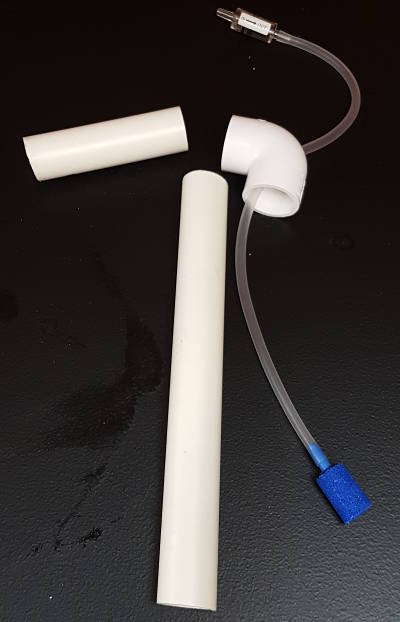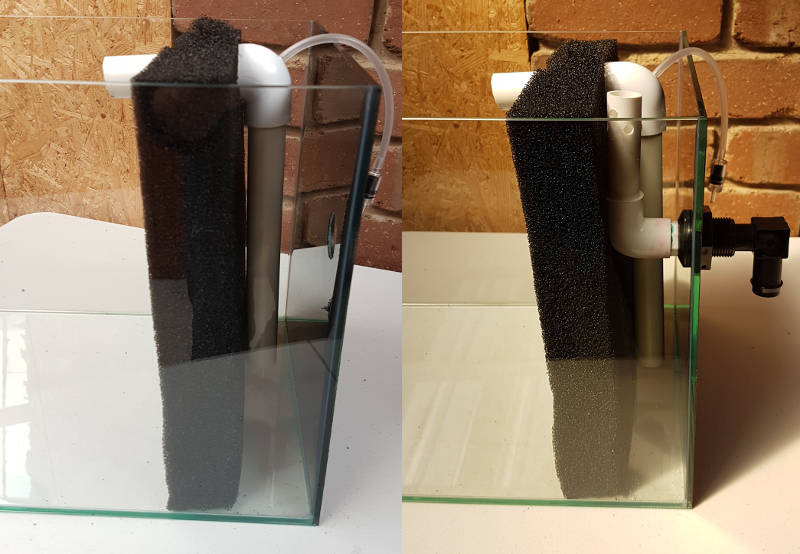What Is A Matten Filter?
The Matten Filter or (Hamburger Matten Filter) is a filter used in the aquarium hobby. Like all aquarium filters the Matten Filters purpose is to filter aquarium water.
The Matten Filter originates from Germany where it was first invented. The Matten Filter is now popular around the world due to its simplicity, effectiveness and how easy they are to make.
How Does A Matten Filter Work?
A Matten filter is made from a sheet of foam and an air driven lift tube. Usually, the sheet of foam is placed close to one end of the aquarium. The air driven lift tube is placed behind the foam sheet and draws water from behind the foam sheet to the front.
The air driven lift tube works by using an air pump to pump air into the bottom of the lift tube. As the bubbles inside the lift tube move to the surface, they draw up water behind them. This results in water flowing up and out the tube.
The movement of water from behind the foam to in front of the foam via the lift tube then forces water to pass back through the foam from the front to the back completing the circulation of water.
As the water passes through the foam the water if filtered. The filtering of water is both mechanical and biological.
- Mechanical filtration - large pieces of debris will be trapped by the foam.
- Biological filtration - beneficial bacteria live and populate within the filter foam and drives the nitrogen cycle breaking down toxic Ammonia to Nitrite and then to Nitrate which is far less toxic to fish.
How To Make A Matten Filter
There are three main parts to cover in making a Matten Filter, the foam sheet, the air lift tube and then the assembly.
Foam sheet
- Aquarium safe foam or sponge sheet should be used. The foam sheet should have a PPI (pores per inch) of 20 - 30 and be between 1 and 2 inches (2.5 to 5cm) thick. The foam sheet should be large enough to cover one side (usually one end) of the tank.
- Cut the foam to be slightly wider than needed so that when pushed into position it will remain firmly in place. The height of the foam should be slightly less than the height of the tank.
- A hole needs to be cut in the foam to fit the lift tube in place. The hole should be just below the top of the foam. The hole should be just smaller that the PVC pipe so that when the PVC pipe is pushed through it will be a snug fit.
Air driven lift tube
The lift tube is made from PVC pipe and one right angle join piece, airline tubing and an air stone. I use 3/4 inch (or 20mm) PVC pipe.
- The main lift tube should sit about 1 inch (2 -3cm) above the bottom of the tank and go almost to the top of the tank. The idea is that once connected to the right angle join the output pipe will be at the water level.
- Drill a hole in the top of the right angle join. The hole should be slightly smaller than the air line being used. Airline should be able to fit through the hole but the fit should be tight. I recommend using high quality silicone air tubing.
- The output pipe is short, 2 to 3 inches, it connects to the right angle join.
- Thread air line tubing through the hole in the right angle PVC join. Attach an air stone and pull enough airline through so that the air stone will sit at the bottom of the lift tube.
- Push the lift tube into the right angle PVC point - I find gluing the PVC is not required just make sure it is press fitted tightly. The air tube should be dangling inside the lift tube.
- Connect the output pipe to the other end of the right angle PVC joint. The lift tube is now assembled.

Assembling the Matten Filter
Completing the assembly of the Matten Filter.
- Push the output pipe of the lift tube through the hole in the top of the foam sheet. The Matten Filter is now complete!
- Place the Matten Filter in the tank by squeezing the foam sheet into position either at one end or side of the aquarium. Make sure it is a snug fit around the sides and bottom.
- Now fill the tank with water and connect the air line to your air pump. I use a airline check valve to protect the air pump form any accidental back flow.
- And there you have it your own DIY Matten Filter!
As with any aquarium ensure you cycle the aquarium, ensuring that the filter is establish with beneficial bacteria to perform biological filtration.

What Are The Advantages Of Matten Filters?
Some of the advantages of Matten filters which make them so popular are:
- They are easy and inexpensive to make
- They are inexpensive to run - air driven from an air pump and many can be run from a single air pump
- They are simple yet effective - no moving parts
- You can hide heaters and other equipment behind them
- They are safe for fry and baby fish - fry will not get sucked into them
- They have a large surface area which house micro-organisms which are great food for fry and shrimp
- They can go along time without cleaning, as the foam sheet is usually quite large it take a long time to clog up before cleaning is required

What Are The Disadvantages Of Matten Filters?
Some disadvantages of Matten filters are:
- They take up room in the aquarium
- To clean them you need to remove them from the aquarium
- They can be noisy as they run on air and make a bubbling sound
Matter Filter VS Sponge Filter
| Matten Filter | Sponge Filter | |
|---|---|---|
| Easy and inexpensive to make? | ✓ | ✓ |
| Inexpensive to run? | ✓ air driven via air pump | ✓ air driven via air pump |
| Can hide heaters and other equipment behind them? | ✓ | ✗ |
| Safe for fry and baby fish? | ✓ | ✓ |
| Effectiveness? | ✓ Yes, very large surface area | ✓ Yes but in large tanks might require more than one |
| Ease of cleaning? | ✗ A bit difficult need to remove from aquarium | ✓ Easier than Matten filter as they are generally smaller and not fixed in position |
I use both Sponge Filters and Matten Filters, I would not say one is overall better than the other it really depends on your scenario.



